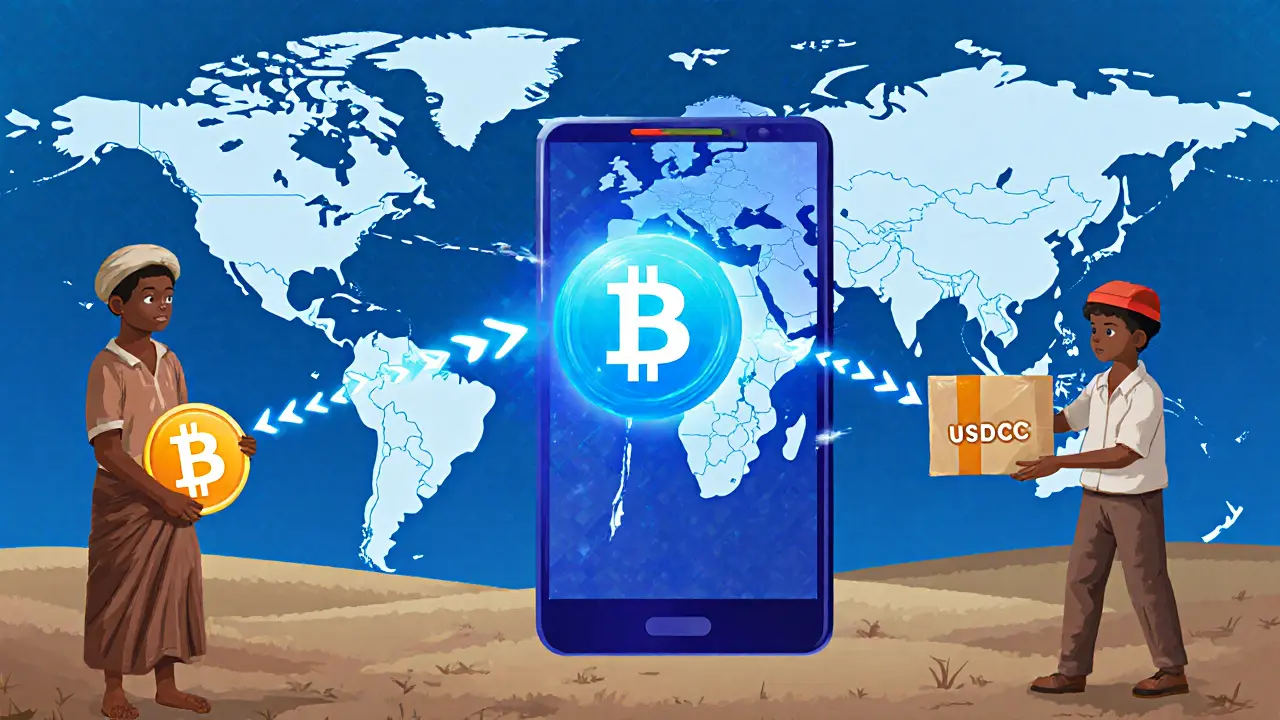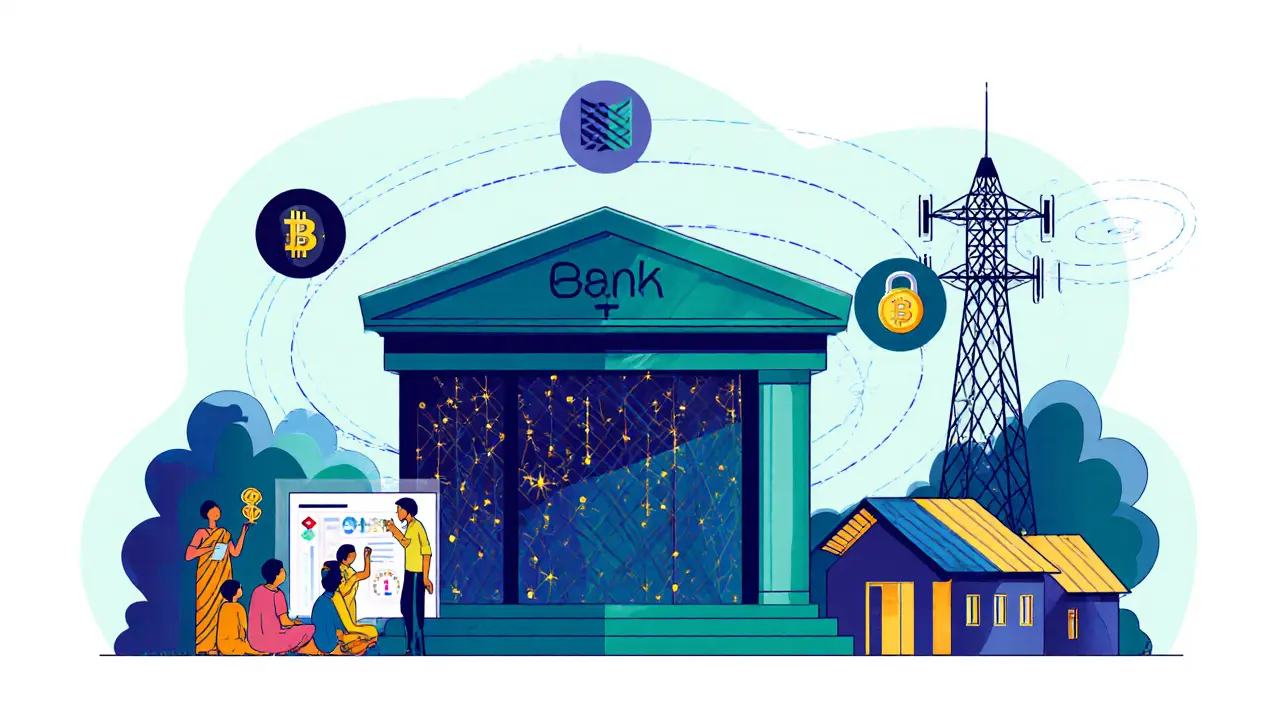How Crypto Boosts Financial Inclusion in Developing Countries

Crypto vs. Traditional Banking Comparison Tool
This interactive tool compares core financial inclusion features between traditional banking and cryptocurrency services.
| Feature | Traditional Banking | Cryptocurrency |
|---|---|---|
| Access (device needed) | Physical branch or ATM plus ID | Smartphone + internet |
| Account opening cost | Often $10-$30, plus minimum balance | Free; wallet creation costs near $0 |
| Transaction speed (domestic) | Same-day to 3-days | Minutes to seconds |
| Cross-border fee | 6-15% of amount | Under 1% (often 0.1-1%) |
| Availability | Limited to banking hours and locations | 24/7 access from anywhere with internet |
| Documentation required | Full ID verification, income proof | Minimal or no verification needed |
Estimate potential savings with cryptocurrency remittances compared to traditional methods:
Potential Savings
Traditional Cost:
Crypto Cost:
Savings:
Percentage Saved:
Key Takeaway
Cryptocurrency enables financial inclusion by removing barriers like physical infrastructure, documentation requirements, and high fees that prevent billions from accessing basic financial services.
Imagine being able to send money to family across the ocean for less than a dollar, keep savings safe from hyper‑inflation, and access a bank‑like service using only a phone. That’s the promise of cryptocurrency financial inclusion for the world’s 1.4billion unbanked adults.
Why crypto matters for the unbanked
Cryptocurrency is a digital asset that lives on a blockchain, a decentralized ledger that anyone with internet access can read and write. Because it doesn’t need a physical branch, a central authority, or a minimum balance, a person can create a wallet in seconds, often with no ID verification required.
The financial inclusion goal is simple: give people the tools to save, pay, borrow, and invest. Traditional banks fail in many developing regions due to poor infrastructure, high fees, and strict documentation. Crypto sidesteps those hurdles, turning a basic smartphone into a gateway for global finance.
Core capabilities that drive inclusion
- Remittances: Cross‑border transfers that normally cost 6‑15% and take days can be completed in minutes for under 1% using Bitcoin, Litecoin, or stablecoins.
- Inflation protection: Fixed‑supply coins like Bitcoin act as a hedge when local currencies lose value at double‑digit rates.
- Cross‑border trade: Small merchants can receive foreign payments without costly forex conversions or bank intermediaries.
Real‑world snapshots
In Kenya, mobile money giant M‑Pesa dominates, but crypto wallets have surged among youths who lack M‑Pesa accounts in remote villages. Nigeria’s crypto trading volume hit >$30billion in 2024, driven largely by people sending money home from Europe and the U.S. Ghana’s central bank is piloting a digital cedi, while farmers in rural Tanzania use Bitcoin to purchase fertilizer from overseas suppliers, avoiding the 12‑day bank transfer lag.
Comparison: Crypto vs. Traditional Banking for Inclusion
| Feature | Traditional Banking | Cryptocurrency |
|---|---|---|
| Access (device needed) | Physical branch or ATMs plus ID | Smartphone + internet |
| Account opening cost | Often $10‑$30, plus minimum balance | Free; wallet creation costs near $0 |
| Transaction speed (domestic) | Same‑day to 3‑days | Minutes to seconds |
| Cross‑border fee | 6‑15% of amount | Under 1% (often <0.5%) |
| Documentation required | Government ID, proof of address | Usually none; some platforms optional KYC |
| Inflation hedge | Limited; savings in local currency | Fixed‑supply assets (e.g., Bitcoin) |

Barriers that still block mass adoption
Even with clear advantages, crypto faces four major obstacle groups:
- Regulatory uncertainty: Many governments lack clear laws, causing banks and merchants to stay on the sidelines.
- Infrastructure gaps: Rural areas still suffer from intermittent internet and limited smartphone penetration.
- Education & security fears: Users often don’t understand private‑key management, leading to lost funds and mistrust.
- Volatility: Price swings can erode the value of stored crypto, making low‑income users hesitant.
Academic reviews from 2025 note that these hurdles cluster under “regulatory and institutional,” “technological and security,” “market and financial,” and “socio‑economic” categories.
Overcoming the challenges: practical steps for stakeholders
- Clear policy frameworks: Governments should issue sandbox‑friendly regulations that protect consumers while encouraging innovation.
- Mobile‑first infrastructure: Partner with telecoms to bundle data bundles with crypto wallets, reducing connection costs.
- Education campaigns: Community workshops that teach key concepts-what a private key is, how to back it up, and how to protect against phishing.
- Stablecoin integration: Using USD‑pegged stablecoins reduces volatility for everyday transactions while preserving crypto’s low‑cost benefits.
- Hybrid banking models: Encourage traditional banks to offer crypto custodial services, giving users the security of a regulated institution with the speed of blockchain.
Beyond payments: tokenization and digital assets
The tokenization of assets-turning a piece of equipment, a farm plot, or a micro‑enterprise’s future cash flow into a digital token-can unlock capital that banks typically deem too risky. The Center for Strategic and International Studies reported pilot projects where African small businesses raised funds through token sales, fostering job creation and local tax revenue.
Central banks in Ghana and Nigeria are also testing central bank digital currencies (CBDCs) designed specifically for the unbanked, blending state backing with blockchain‑style accessibility.
TL;DR - Quick takeaways
- Crypto needs only a phone and internet, cutting out costly middlemen.
- Remittances, inflation hedging, and cross‑border trade are the three strongest use cases.
- Regulation, connectivity, education, and volatility are the biggest hurdles.
- Solutions include clear policies, stablecoins, hybrid bank‑crypto services, and community training.
- Tokenization and CBDCs point to a broader future where digital assets boost inclusion beyond simple payments.
Looking ahead
When regulators draft balanced laws, when telecoms expand reliable 4G/5G coverage, and when NGOs fund crypto literacy, the unbanked could finally step into the global economy without waiting for a brick‑and‑mortar branch.
The next decade may see a hybrid landscape: traditional banks handling credit and savings, while crypto and tokenized assets power fast, cheap, and borderless everyday transactions. If all pieces click, cryptocurrency could become one of the most transformative tools for financial inclusion in developing countries.

Frequently Asked Questions
Can I use crypto without a bank account?
Yes. A crypto wallet only needs a smartphone and internet. You can receive, store, and send funds without ever opening a traditional bank account.
How cheap are crypto remittances compared to services like Western Union?
Typical crypto fees range from 0.1% to 1% of the transfer amount, while Western Union and similar providers charge 6%‑15% plus a fixed markup.
What about price volatility? Won’t my money lose value?
Volatility is a real risk for major coins like Bitcoin. Many users mitigate it by converting crypto to stablecoins (e.g., USDC) for everyday spending, then swapping back when needed.
Are there any legal risks using crypto in my country?
Legal landscapes differ. Some nations have clear guidelines, others treat crypto as a gray area. Always check local regulations and consider using regulated exchanges that follow KYC/AML rules.
How can tokenization help small businesses?
Tokenization converts a business’s future revenue or assets into digital tokens that investors can buy. This provides capital without needing a bank loan, and the tokens can be traded on secondary markets.

16 Comments
It’s hard not to wonder why the global financial elite keep pushing the narrative that crypto is a wild west of fraud, when in fact the technology is the only thing that can break the stranglehold they have on the poor. The same institutions that guard the vaults of the world’s richest are the ones that outlaw decentralized money under the guise of “consumer protection.” Yet every time a developing nation opens a gateway for its citizens to exchange a few dollars for a stablecoin, the profit margins of those shadow banks shrink. I see a coordinated campaign to keep this technology suppressed, and I refuse to stay silent about it. The argument that crypto is too volatile ignores the fact that the volatility is a symptom of a system that has been artificially inflated by central bank policies. You can’t claim that decentralized finance is a risk when the real risk is a stagnant economy where people cannot even open an account without a birth certificate. Moreover, the digital divide is not a myth; it is a manufactured barrier that is reinforced by the same multinational corporations that own the telecom infrastructure. By forcing costly know‑your‑customer procedures, they keep the unbanked out of the system and maintain a labor force that can be exploited. Every transaction fee that a traditional bank levies is later siphoned into the pockets of lobbyists who write the laws that criminalize crypto. If you truly care about financial inclusion, you should be asking why the powerful fear the loss of their monopoly, not whether the technology is perfect. The evidence is everywhere: in Kenya, in Nigeria, in the hidden forums where developers discuss how to bypass state‑run censorship. The truth is that crypto is the cheapest, most accessible bridge to the global economy, and that is exactly why they want to shut it down. In the end, the choice is clear-either we stand with the people who want to claim their own financial agency, or we will continue to be pawns in a game designed by the banking oligarchy.
Sure, crypto will totally solve all your problems.
One musst admit the whole "crypto is a saviour" narrative is a little bit overdramatic, especially when you consider the sheer volume of hype that surrounds it; i mean, have you actually read the whitepaper of most coin projects? Gosh the grammar is often a disaster, and the tokenomics sometimes make no sense at all. Yet people keep proffering these tokens as if they're gold. It's almost as if the market is a circus, and we are all the clowns trying to juggle the blockchain lambdas while the audience throws endless cat memes. Maybe the real issue is that we, as a global community, are so quick to embrace novel tech without giving it the proper scrutiny or the rigorous peer review that any scientific breakthrough deserves. Still, i think there's a deep, undeniable value in the ability to move money across borders without needing a middleman-provided we manage to tame the volatility and the regulatory uncertainty that are part and parcel of this ecosystem.
Let me paint a picture drenched in technicolor: imagine a world where every remote village in the Sahel can bypass the dusty, crumbling banks and instead tap into a luminous digital ledger that glows like the aurora borealis on a moonless night. This is not some far‑flung sci‑fi melodrama; it is the very essence of crypto’s promise, wrapped in the shimmering tapestry of decentralized finance. Yet the powers that be seem to whisper in hushed tones, fearing that this luminous beacon could outshine their dim, oil‑lit lanterns of control. The irony is delicious-while they chant about stability, they hide their own fragility behind layers of bureaucracy and opaque fees that bleed the lifeblood from the poorest. If we dare to picture a future where a farmer in Tanzania sends a fraction of a Bitcoin to purchase fertilizer without waiting weeks for a bank transfer, we glimpse the very heart of emancipation. It is a rebellion of logic against the illogic of institutional inertia, a symphony of code that sings the song of freedom across continents. In the end, the cryptographic alchemy that transforms cryptic code into accessible wealth is nothing short of a modern miracle, and it deserves our most fervent applause.
From a philosophical standpoint, one must contemplate the ontological implications of decentralised monetary systems in contrast to the hegemonic structures of traditional banking. The latter, entrenched in a paradigm of fiduciary fiat, perpetuates a centralized authority that exercises coercive control over the populace’s economic agency. Conversely, cryptocurrency, through its immutable ledger, embodies a form of digital sovereignty that aligns with the libertarian ideal of self‑ownership. It is, therefore, not merely a technological innovation but a paradigmatic shift that challenges the epistemic foundations upon which contemporary financial institutions are built. Moreover, the ethical dimension cannot be ignored: by eliminating arduous KYC procedures, crypto ameliorates the exclusionary practices that marginalise the unbanked. Such an emancipation aligns with the moral imperative to promote equitable access to financial tools. In sum, the convergence of technological, philosophical, and ethical considerations underscores the transformative potential of cryptocurrency as a catalyst for inclusive prosperity.
While Lara paints a grand conspiracy, the reality on the ground is a lot less theatrical. In many of the communities you mention, crypto is just another tool-sometimes useful, sometimes not. It’s great that you’re passionate, but let’s not turn every nuance into an apocalyptic warning. The actual challenges are infrastructure, education, and yes, a fair amount of regulatory gray zones. If we focus on those practical obstacles, we can make measurable progress rather than just spouting alarmist rhetoric.
Even a tiny bit of optimism can go a long way for those trying out crypto.
In addition, when considering the adoption curves, it is essential to note that mobile penetration in Sub‑Saharan Africa exceeds 70 %, which provides a fertile ground for crypto wallets; consequently, developers should prioritize lightweight, low‑bandwidth applications, and integrate local language support, thereby reducing friction for end‑users and fostering sustainable growth.
Crypto isn’t a magic bullet; it has its own set of flaws.
One must acknowledge, with a blend of admiration and melancholia, the sheer audacity of those who champion cryptocurrency as a panacea for systemic inequities, while simultaneously neglecting the sociocultural latitudes that inform monetary behavior. The discourse frequently oscillates between hyperbole and nihilism, leaving little room for a nuanced interrogation of the underlying power dynamics that regulate access to capital. Indeed, the very act of framing crypto as an egalitarian instrument can be perceived as a subtle perpetuation of the same neo‑liberal dogma that venerates market solutions to every social ill. Moreover, the romanticisation of blockchain narratives often eclipses the stark realities of energy consumption, market volatility, and the precarious legal frameworks that can, in practice, exacerbate the disenfranchisement of the very populations it purports to uplift. In this light, the question arises: are we merely substituting one form of techno‑optimism for another, without addressing the structural foundations that sustain exclusion?
I appreciate the points made, even if we see them differently.
While maintaining a formal tone, it is evident that constructive dialogue necessitates precise articulation of both benefits and risks, thereby fostering informed decision‑making processes among stakeholders.
Hey, let's keep the vibe upbeat-crypto could really help a lot of folks out there!
From a cultural perspective, introducing crypto solutions requires sensitivity to local financial practices, yet the potential for increased autonomy is significant.
It’s clear that solutions must be adaptable; some communities will embrace crypto fast, while others may need more time and education. The key is listening and iterating.
We cannot, in good conscience, remain indifferent to the moral imperative of empowering the unbanked through technology that is, at its core, democratizing. To turn a blind eye to the transformative capacity of cryptocurrency is to endorse a status quo that thrives on exclusion and exploitation. Let us, therefore, champion the cause of inclusive finance with conviction, recognizing that every transaction facilitated without undue fee is a step toward justice. The ethical dimension of this dialogue demands that we prioritize human dignity over entrenched profit structures, and align our actions with the higher purpose of equitable access for all.